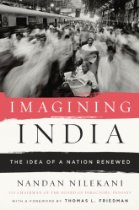When Nandan Nilekani was the CEO of Infosys, one of India’s top IT and outsourcing firms, he often found himself being forced to answer questions not just about his company but also his country. Sometimes, global business executives who visited the company’s sprawling campus in Bangalore would raise issues to which Nilekani had no answer — such as, “Why does Infosys have such a beautiful campus, but also large slums in other parts of the city?” So when Nilekani decided to write a book, unlike other CEOs who write about their favorite leadership or management theories, he chose India as his subject. In Imagining India: The Idea of a Renewed Nation, Nilekani tackles themes ranging from education and demographics to investment and infrastructure. Nilekani, who was recently recruited by Indian Prime Minister Manmohan Singh to head a project to create a national identification card for the country, spoke with India Knowledge at Wharton about the book at the recent Wharton India Economic Forum in Philadelphia.
An edited excerpt of the interview appears below:
India Knowledge at Wharton: Normally when corporate CEOs write books, they tend to write either about their biggest deals or about their perspective on management theory or philosophy. You wrote a book about India. Why?
Nandan Nilekani: Well, you know, I wanted to do something different. My role in the last several years has been going around the world and projecting India in global forums and all that, and I was not able to answer a lot of questions that people would ask me. They would ask me, “Why is it that you have such beautiful campuses like Infosys and such large slums? Why is it that there are so many billionaires and so many poor people? Why is it that you have all the educated people in technology and the world’s largest illiterate population? Why is it that you guys seem to coexist in the 17th Century and the 21st Century at the same time?” When asked questions like these, I was not able to give very convincing answers, so I felt the need to get down to the bottom of, “Why are we the way we are?”
The other important thing, I felt, was that India had a very small window of opportunity. It had this huge demographic dividend and this young population, but that demographic dividend could well become a demographic disaster if we did not make the right investments in our human capital. I felt that window of opportunity was passing by, so I thought it would be good to write it down and say, “Hey guys, we have this beautiful opportunity, let us not mess [it up].”
Also I found that a lot books on India were written from a particular perspective, an economist’s view or a sociologist’s view. I felt that to really give India its due you had to take a much more holistic look at it — which is why I looked at the country from all these angles. I interviewed 126 people, and it is a sort of a composite of all that.
India Knowledge at Wharton: In the introduction you say that the most important driver of growth lies in expanding access to resources and opportunity. What are the major barriers that block this access for millions of Indians, and how can they be removed?
Nilekani: One clear barrier to access is education. The opportunities for somebody, say, who lives in Bangalore and goes to an English medium school and goes to the Indian Institute of Technology [are] dramatically different from a young child in Bihar who does not have a school in his village. And, therefore, access to education and providing good education in the public space is very important.
Second is access to English. We have really practiced very hypocritical policies on English. We have denied English to our people and, therefore, they have not learned the language. English has become the language to participate in the global economy.
Or consider access to roads. If you live in a village and need to go to school, you need to have a road to go to school or you need lights at night to study. These are very simple things. If you deny people these basic instruments–of education, health, infrastructure, jobs — then you are bound to deny them access to building a better life.
India Knowledge at Wharton: Let’s go back to the phrase you used a little earlier, the “demographic dividend.” In the 1960s, India’s population was seen as a burden but now you use the term “human capital” to describe India’s population. How do you think that the demographic dividend divides across the country? Is it growing at the same pace or are there regional differences?
Nilekani: There are three or four things here. A demographic dividend is typically a point in the country’s history when the bulk of its population is in the working age of 15 to 65. And, therefore, the country has a low dependency ratio. In other words, they support fewer retired people and have more people to work — and that is typically the Golden Age of any nation. Since you have more people working, you have more creativity and so on. India is very fortunate to be having its demographic dividend now; it is the only country in the world which is having its demographic dividend. So it is not only a young country with a dividend, it is a young country in an ageing world — and this opens up even more strategic possibilities.
India’s demographic dividend is not one curve; there are two curves. There is one curve, which is in the south and the west of India, which is almost fully absorbed. By 2015, the south and the west will start ageing. There is a second curve–which is in Middle India, which includes the central states of UP, Bihar, Chhattisgarh, Orissa, Madhya Pradesh–and that is going to be the next demographic bubble. Unless we address very fundamental issues in that region — of education and access and all that — that is really going to be a big challenge. Today you see, for example, many problems of migrant workers coming to Mumbai, and the [hostile] reactions to them. What you see is really a small part of what will happen if we do not address this very quickly, because in the years from 2001 to 2025, only 12.6% of the new population in India is going to be in the south; 50% is going to be in the northern states. There is a huge difference because fertility rates in states like Kerala today are like a West European country; it is one-third of what it is in Uttar Pradesh. We have to understand these nuances of what is happening, to really think through what we need to do.
India Knowledge at Wharton: How should India deal with this second bubble?
Nilekani: It has to be addressed by expanding access [for] that young population. It is about improving the quality of schooling; it is about better infrastructure; it is about job creation there as opposed to job creation by migration. For all these things, we do not have much of a window. We have maybe four or five years to pull it off…because, otherwise, the pressure of the disparities will go up even further.
India Knowledge at Wharton: Much like the issue of India’s population, there is another area where the country has seen a sea change in its thinking. Soon after independence in 1947, it was assumed that India needed democratic socialism. You point out in your book that there has been a transformation in this way of thinking, with much greater acceptance of business-friendly, capitalist policies. But now, when you come to the U.S., and see what a mess the subprime crisis has made of this economy, is this the kind of economic system that India needs? What kind of capitalism does India need?
Nilekani: I think the message is that we need to find the right balance between markets and regulated society. If you have markets that are unregulated and untrammeled, they can lead to a situation where they create the kind of challenges we have in the U.S. And then you have the reaction to that, which you are seeing today.
The challenge is to find the right balance. India has the opportunity to find the right balance, because we had veered too much to one side. [That] does not mean that we have veered too much to the other side. But [we need to] strike the right juxtaposition of entrepreneurship, business and the markets. I know that you need market forces and entrepreneurs to create jobs, to create innovation, to create new products and services, to improve productivity, to improve the quality of life and so on. You cannot do that [via] the state. But you need the state to create a regulatory and other frameworks, and rule of law to ensure that businesses play within the same playpen. I think that is the message from what is happening here. India is very fortunate that it has, I believe, the largest array of entrepreneurs anywhere in the world, except the U.S. We have large companies in the family sector; we have large companies in the public sector; we have large global companies; and we have thousands of young entrepreneurs. It is a diverse and rich base that we need to take advantage of.
India Knowledge at Wharton: Your book also talks about the impact of technology in transforming different industries. You also write about the success of India’s IT sector in providing IT services and BPO services to the world. Alongside this success story, though, along comes the Satyam scandal. (In January 2009, Satyam Computer Systems chairman Ramalinga Raju resigned over the falsification of the company’s accounts — the company has now been acquired by Tech Mahindra.) What sort of an impact has that had on the way Indian IT companies are perceived?
Nilekani: Satyam was a specific case of fraud. It happened to be somebody who was in the IT sector, who also got into some real estate activities. So, it was a case of fraud. I do not think it in any way takes away from the enormous success of what technology has done [for the] Indian economy and society.
India Knowledge at Wharton: Tom Friedman, in the Foreword to your book, calls you “the great explainer.” What I am hoping you will explain is how such a huge fraud could go on undetected for such a long time. When you talk to your clients, do they see this as an isolated instance?
Nilekani: Yes, absolutely it is seen as an isolated instance — because it is a case [of] one entrepreneur going errant. I guess it is all part of what happens in a bubble. I mean, look at the Bernie Madoff $50 billion scam. Nobody seemed to know about it and some very, very influential and knowledgeable people seem to have put money there. It is difficult to say where you draw the line on these things.
It was an unfortunate episode because we have been trying to project India’s entrepreneurs as the new face of India. This incident took us back, because the whole argument was predicated on the statement that these were good, honest entrepreneurs. It was a setback for the Indian image we wanted to build, but it is very much an isolated instance. I think we have excellent companies today in India which are — and I think the technology story is huge because people tend to see the technology story as the stuff which has to do with outsourcing — which is a huge achievement.
But how technology has been used within the country is an equally compelling story. In India’s recent election with 700 million voters, some 1.1 million voting machines were deployed and they were all electronic. No other country on the planet has gone to a completely electronic way of voting.
Moreover, consider what people at ICICI Bank have done using technology. I have offered many such case studies in my book. They have transformed the way the common man gets access to banking. I think technology has played a huge role not only in the external side but also domestically.
India Knowledge at Wharton: In India much grumbling is heard about the infrastructure goes, but as you note in your book, in telecommunications infrastructure has worked extremely well. Are there any lessons that the rest of India could learn from the telecommunications experience?
Nilekani: Yeah. I think a couple. Telecom is a huge story and today we are talking about [adding] 8 million [new] mobile phones a month; 99% of the mobile phones are prepaid which means they are being taken by people who do not have a credit history. And 40% of the prepaid charge is less than 10 rupees (20 cents) a pop, which is a phenomenal achievement of really creating a mass movement.
I think a part of it was the regulatory environment being changed. There are some challenges there but still it is trying to create a playing field between both public and private money. And also I think technology played a big role because you had a huge Moore’s Law kind of thing operating there. [In a 1965 paper, Intel co-founder Gordon Moore postulated that the number of transistors that could be built into an integrated circuit chip had doubled roughly every two years since 1958 and would continue to do so for the foreseeable future. This formulation of what has come to be called Moore’s Law has been used to explain the fall in technology prices.]
The infrastructure is growing elsewhere too. Airports are coming up: the Bangalore Airport has come up; the Hyderabad Airport has come up; Bombay and Delhi are getting redone. The highways, of course, did slow down a bit; but there has been a lot of movement on highways. I do see a lot of improvements in infrastructure.
India Knowledge at Wharton: One last question: Since your book is titled, “Imagining India,” what kind of an India would you imagine for your grandchildren and their children?
Nilekani: My point in this book is to say that India is at a strategic opportunity. This is a result of its demographics, its entrepreneurs, its technology prowess, its democracy, the fact that the world is ageing while we are young; the fact that we have English as a language. All these are unique attributes.
If we make full use of this opportunity, India could be a role model for the 21st century. The reason is that you are talking about a billion people reaching prosperity, living in a peaceful manner, in a democracy, handling extraordinary diversity. I mean, the whole issue today is the so called “clash of civilizations.” India has — daily — all those civilizations, and yet they all co-exist. The ability to show this combination of development, diversity and democracy, will make India a very successful country, if we do it right.
But we can also go the other way. The same demographic dividend could turn into a disaster if we do not harness the energy of our people well. Once their aspirations have been unleashed, they could become disgruntled and disaffected by lack of jobs and lack of economic growth, and then they can also become a source of violence and divisiveness. We are on the razor’s edge. It is up to us to decide whether we go this way or that way.



